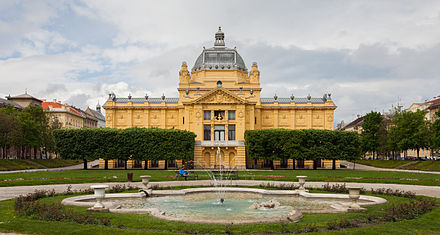Austro-Hungarian Empire
Austro-Hungarian Empire
See also: European history
The Austro-Hungarian Empire (German: Österreichisch-Ungarische Monarchie, Hungarian: Osztrák–Magyar Monarchia) and its predecessors (the Habsburg Monarchy, and the Austrian Empire) dominated Central Europe and the northern Balkans from the end of the Middle Ages until its collapse at the end of World War I. At the time of its greatest extent, in the mid-19th century, it spanned about a thousand miles (1600 km) from Pavia in Northern Italy to Ternopil in Western Ukraine.
The empire was ruled by the House of Habsburg, arguably Europe's mightiest dynasty. All countries within the Austro-Hungarian realm are republics today, very few people with memories from the empire are alive, and very few heirs to the Habsburg family are left; still, many palaces and artefacts have survived to this day. And even though the Cold War has severed many ties, feelings of kinship and cooperation still and once more exist between the former parts of the empire.
During the 19th century, the empire was often seen as horrendously "backward" and in an era of rising nationalism it was dubbed "prison of nations". However, the "Austrian" half of the empire in particular granted remarkable linguistic and cultural rights for minorities and in the 21st century, the attempt at peaceful multi-ethnic coexistence – however flawed it was – is often retrospectively seen as something lost in the catastrophic World War I, rather than a "backwardness" to be replaced by ethnically cleansed nation states.
Regions
Empire of Austria (Cisleithania):
-
Carniola (see Slovenia)
-
Dalmatia (including the Bay of Kotor)
-
Galicia (see Małopolskie, Podkarpackie and Western Ukraine)
-
Austrian Littoral (see Istria, Gorizia-Gradisca, and Trieste)
-
Moravia (see North Moravia and Silesia and South Moravia)
-
Silesia (see North Moravia and Silesia)
-
Styria (including Eastern Slovenia)
-
Tyrol (including South Tyrol)
Kingdom of Hungary (Transleithania):
-
Hungary including Slovakia, Burgenland, Transylvania, Crișana, Maramureș, Banat and Vojvodina
- Fiume (un-numbered)
Austro-Hungarian Condominium:
Older provinces, lost before the Great War
Overseas possessions:
- Tianjin (part)
Understand

Meanwhile, the East Roman Empire survived as the Byzantine Empire, ruled from Constantinople. As the city was lost to the Ottoman Empire who changed the capital's name to Istanbul, both the Ottomans themselves and the Russian Empire claimed succession from Rome. The Ottomans and Russia came to be Austria's main rivals, though occasionally their allies.
.JPG/440px-Melk_-_Stift_(2).JPG)
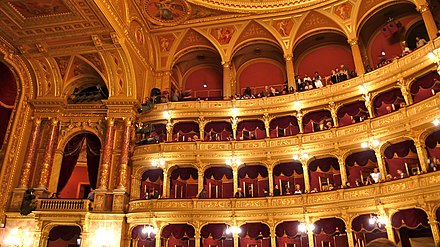 While the Protestant Reformation swept northern Europe, Austria remained Catholic. In the early 17th century, Protestant states revolted against the Holy Roman Empire. The conflict evolved to the Thirty Years' War, in which the Holy Roman Emperor lost all significant power outside Austria and Bohemia. The multiethnic Habsburg Monarchy, lying partly within and partly outside the Empire, became a great power in its own right, and a destination on the Grand Tour. Vienna became a centre for European classical music and other arts, boasting composers such as Haydn, Mozart, Beethoven, and Schubert.
While the Protestant Reformation swept northern Europe, Austria remained Catholic. In the early 17th century, Protestant states revolted against the Holy Roman Empire. The conflict evolved to the Thirty Years' War, in which the Holy Roman Emperor lost all significant power outside Austria and Bohemia. The multiethnic Habsburg Monarchy, lying partly within and partly outside the Empire, became a great power in its own right, and a destination on the Grand Tour. Vienna became a centre for European classical music and other arts, boasting composers such as Haydn, Mozart, Beethoven, and Schubert.
Following the 1789 French Revolution, the Kingdom of France became Austria's main rival in the French Revolutionary Wars, and later the Napoleonic Wars. Napoleon Bonaparte became Emperor of the French in May 1804 to usurp the Imperial glory. He planned to conquer more of Europe, and thereby chances to be elected as Holy Roman Emperor. Francis II styled himself Emperor of Austria two months later, to secure his title. In 1805, Napoleon defeated Austria, and forced them to cede much territory. Francis formally dissolved the Holy Roman Empire in 1806, to avoid losing the crown to Napoleon. Austria was weakened, and defeated by Napoleon again in 1812. As much of Napoleon's army perished in a campaign against the Russian Empire, Austria joined a coalition that eventually defeated the Napoleonic Empire, and the 1815 Congress of Vienna restored the Austrian Empire as one of Europe's great powers.
_2015-01.jpg/440px-HUN-2015-Budapest-Hungarian_Parliament_(Budapest)_2015-01.jpg) Prussia led an alliance that defeated Austria in the 1866 Austro-Prussian war, and became the core state of the German Empire in 1871, with an emperor of their own. Austria-Hungary was no longer the dominant power in Central Europe. However, the 1870s Gründerzeit ("founders' period") brought a great economic boom as well as a long-lasting construction boom and the emergence of a highly ornamental, eclectic-historicist architectural style that is considered typical for the Habsburg lands. The most representative examples of this period are along the Vienna Ring Road, but buildings of a similar style can be found all over the former Empire.
Prussia led an alliance that defeated Austria in the 1866 Austro-Prussian war, and became the core state of the German Empire in 1871, with an emperor of their own. Austria-Hungary was no longer the dominant power in Central Europe. However, the 1870s Gründerzeit ("founders' period") brought a great economic boom as well as a long-lasting construction boom and the emergence of a highly ornamental, eclectic-historicist architectural style that is considered typical for the Habsburg lands. The most representative examples of this period are along the Vienna Ring Road, but buildings of a similar style can be found all over the former Empire.
In contrast to most other European empires, Austria-Hungary had no persistent colonies overseas. In 1778, the Empire founded settlements on the Nicobar Islands, and on Maputo Bay in Mozambique. Both were abandoned within a few years. After suppressing the Qing Dynasty-backed Boxer Rebellion as part of the Eight-Nation Alliance in 1901, Austria-Hungary had a concession zone in Tianjin from 1901 to 1917.
In the 19th century, particularly in the long reign of emperor Franz Joseph (1848-1916), nationalism swept Europe, and many ethnic groups requested independence, or at least more autonomy. The Kingdom of Hungary earned more recognition in the Compromise of 1867, styling the empire as Austria-Hungary. While other European countries were formed or reformed according to nationalist and democratic ideas, the empire was still based on divine right, feudalism, and royal marriages. After 1867, many institutions of the Empire were styled "imperial and royal", referring to the two crowns of Austria and Hungary, kaiserlich und königlich in German. This was usually abbreviated to "k. u. k." in Austria and "k. k." in Hungary (the butt of many jokes in military and diplomatic circles) and led to the country's nicknames "k. u. k Monarchie" or "Kakanien".
Discontent among the Slavic peoples was supported by the Russian Empire, and led up to the 1914 assassination of Franz Joseph's heir Archduke Franz Ferdinand (married to a Czech countess, he supported Slavic rights within the empire, if only to knock down the Magyars a peg) in Sarajevo, which became the igniting spark of World War I; at its time known as "The Great War". The war and the subsequent political revolts led to the fall of Austria-Hungary, as well as the Russian, German and Ottoman empires.
The empire was a forerunner in science and technology. Vienna and Prague were connected by a telegraph line as early as 1847. The Telefon Hírmondó was a broadcast service in Budapest founded in 1893, the first and most successful of its kind. Budapest arguably has the world's second oldest underground railway. The Orient Express was a legendary rail line, with much of its length through Austria-Hungary.
Other than Austria and Hungary, the empire's territory is today divided between Italy, Slovenia, Croatia, Bosnia and Herzegovina, Serbia, Romania, Ukraine, Slovakia, the Czech Republic and Poland.
Get around
The Austro-Hungarian Empire was tied together by railroads and many of them survived the Cold War and the general neglect of railway infrastructure in the twentieth century or have been restored in recent times. In addition to that, there was an effort even through the years of European division to ensure a state of good repair for some roads linking Germany and other destination countries for work migrants with their former homelands to the South and East. As the Iron Curtain opened, traffic flows changed once more and the Austrian Railway, ÖBB, is slowly but surely acquiring an amount of international connections out of proportion with the size of the country, largely focused in the "k.u.k. lands" (kaiserlich und königlich, i.e. the former Austria-Hungary), Germany and Switzerland.
Talk
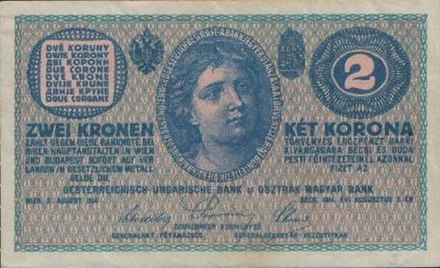 German used to be the lingua franca of the empire and Central Europe in general. This ended after World War II, as millions of German-speakers were expelled from the Soviet Union, Poland, Czechoslovakia and several other nations, to present-day Germany and Austria. Still, the empire was multi-ethnic, with recognition of local languages—its krone banknotes bore text in no less than eight languages in addition to German and Hungarian. During the 19th century the Hungarian half of the Empire had an even more aggressive language policy marginalizing linguistic minorities and strongly Magyarizing many places, the effects of which can be seen to this day.
German used to be the lingua franca of the empire and Central Europe in general. This ended after World War II, as millions of German-speakers were expelled from the Soviet Union, Poland, Czechoslovakia and several other nations, to present-day Germany and Austria. Still, the empire was multi-ethnic, with recognition of local languages—its krone banknotes bore text in no less than eight languages in addition to German and Hungarian. During the 19th century the Hungarian half of the Empire had an even more aggressive language policy marginalizing linguistic minorities and strongly Magyarizing many places, the effects of which can be seen to this day.
In addition, the Austro-Hungarian Empire was, for a time, a major patron of operas in Italian as well as German, and many of the upper class German-speaking subjects of the empire also understood some Italian and French. German still plays some role as a second or third language in the area, but oftentimes it has been relegated to a secondary position behind English or Russian, not least because the German-language states want to avoid the appearance of cultural imperialism.
Destinations
Austria
- Vienna (Wien; Bécs), 48.208°, 16.373°. The primary capital. Big parts of its architecture and urban design date from an era when it was supposed it would "soon" become a major imperial capital of four million or more inhabitants
- Graz, 47.0667°, 15.4333°. Capital of Inner Austria, with an Old Town recognized by the UNESCO. The famous Schlossberg fortress repelled many Ottoman attacks.
- Salzburg, 47.8°, 13.05°. Former capital of an archbishopric that was a separate state within the Holy Roman Empire and was only annexed by Austria in 1805. Hence, Salzburg's most famous son, Mozart, was considered a foreigner when he came to Vienna. 2019-11-12
- Melk, 48.2282°, 15.3306°. Enormous Baroque abbey looking over the picturesque Danube valley of Wachau. An exemplary symbol of Counter-Reformation and absolutistic pageantry.
- Neusiedl Lake (Fertő), 47.833°, 16.75°. Located on the Austro-Hungarian border in the multiethnic Burgenland region (German-speaking Austrians, Hungarians, Croatians), the cultural landscape around the lake is a UNESCO World Heritage site. 2019-11-12
Hungary
- Budapest, 47.4908°, 19.081°. The capital of the Hungarian half of the empire. It boomed massively during the late-19th century, resulting in splendid boulevards lined with representative Habsburg-style buildings, and one of the first subway lines in the world.
- Győr (Raab), 47.6882°, 17.6344°. Former "royal free city" of the Kingdom of Hungary, traditional trade center with Baroque old town. Since the transformation of 1990 it is once again an economic boomtown in the centre of the triangle Vienna–Bratislava–Budapest.
- Pécs (Fünfkirchen; Five Churches), 46.0764°, 18.228°. Hungary's fifth largest city has a strongly multicultural heritage. The cultural centre of Hungary's Germans and Romani hosts associations and cultural institutions of nine ethnic minority groups.
- Sopron (Ödenburg), 47.6817°, 16.5917°. Beautiful old town with medieval and Baroque buildings. It belonged to the Hungarian half of the empire even though the majority population was German-speaking.
- Szeged (Segedin), 46.2539°, 20.149°. Temporary capital of Hungary during the 1848/49 revolution; now located near the Hungarian–Romanian–Serbian border triangle. Famous for paprika and salami.
Bosnia-Herzegovina
- Sarajevo (Sarajewo; Szarajevó), 43.85136°, 18.38867°. The city where Archduke Franz Ferdinand was assassinated, marking the beginning of the end for the Empire.
Croatia
- Zagreb (Agram; Zágráb), 45.8167°, 15.9833°. Capital of Croatia, which was an autonomous kingdom within the Empire.
- Rijeka (Fiume; St. Veit am Flaum), 45.3278°, 14.4445°. Mediterranean seaport that belonged to Hungary but had a multiethnic population of Italians, Croats, Slovenes, Hungarians and Germans. After the dissolution of Austro-Hungary, it was subject of the "Fiume Question", leading to the creation of a short-lived independent free state.
Czech Republic
.jpg/440px-Karlovy_Vary_pohled_od_stezky_Jeana_de_Carro_(4).jpg)
- Prague (Prag; Praha), 50.0664°, 14.373°. Capital of the Kingdom of Bohemia that was the Habsburg rulers' main residence from 1583 to 1611.
- Brno (Brünn), 49.2°, 16.6167°. Historic capital of the Moravia region and second-biggest city of the Czech Republic. It grew significantly during the 18th and 19th century which can be seen from its typical Habsburg-style architecture. 2019-11-12
- Český Krumlov (Böhmisch Krumau), 48.8111°, 14.3152°. One of the most beautiful old towns in Bohemia with rich Baroque architecture and an impressive castle. Until 1945, most of the population was German-speaking. 2019-11-12
- West Bohemian Spa Triangle (Westböhmisches Bäderdreieck), 50.2305°, 12.8725°. Karlovy Vary (Carlsbad), Františkovy Lázně (Franzensbad) and Mariánské Lázně (Marienbad) – the Austro-Hungarian aristocracy's favorite places to relax and recover.
- Slavkov u Brna (Austerlitz), 49.153°, 16.8786°. Site of the Battle of Austerlitz of 1805, also known as the Battle of the Three Emperors, Austria's decisive defeat in the Napoleonic Wars. 2019-11-19
- Lednice–Valtice Cultural Landscape (Lednicko-valtický areál; Kulturlandschaft Eisgrub–Feldsberg), 48.781°, 16.786°. Vast landscape park with several palaces and stately homes, created under the Dukes of Liechtenstein during the 17th to 19th centuries. UNESCO World Heritage site.
- Site of the Battle of Königgrätz, Sadová (15 km northwest of Hradec Králové), 50.2972°, 15.7403°. Decisive Prussian victory over Austria in the German Fraternal War (1866). It marked the exclusion of Austria from Germany and led to the Austro-Hungarian Compromise of 1867, the rift within the lute of Austrian great power status.
Italy

- South Tyrol (Südtirol; Alto Adige), 46.5°, 11.33°. A predominantly German-speaking region that was separated from Austrian Tyrol after World War I.
- Trieste (Triest; Trst), 45.6333°, 13.8000°. The empire's major port and naval base. Europe's three main cultural and linguistic regions meet here: Romance, Germanic, and Slavic.
- Milan (Mailand; Milano), 45.4625°, 9.1864°. The Northern Italian city was under Austrian rule from 1704 until the Italian Risorgimento 1859. During that period, the Teatro alla Scala was built and Verdi's opera Nabucco debuted. 2019-11-12
- Venice (Venedig; Venezia), 45.4386111°, 12.3266°. Once the seat of the mighty Venetian Republic and the cradle of the Renaissance, Venice was only briefly part of Austria-Hungary, and some Habsburg obelisks and monuments in Venedig remain.
Poland
- Kraków (Cracow; Krakau), 50.06185°, 19.93686°. The erstwhile royal capital of Poland was a Free City under shared Austrian, Prussian and Russian protectorate until it was annexed by Austria in 1846. In the following decades it served as the cultural centre of the Empire's Polish possessions, until Polish sovereignty was restored in 1918. Representative architecture from the late-19th and early-20th century along the main boulevards are reminiscent of Vienna or Budapest.
- Wrocław (Breslau), 51.1098°, 17.0327°. The capital of Silesia belonged to the Bohemian crown, and therefore the Habsburg Empire, until Prussia won the First Silesian War in 1742. Nevertheless many Renaissance and Baroque buildings remain from the Austrian era. With its cosmopolitan lifestyle, theatres and numerous cafés, the city still has a certain Viennese charm.
Romania

- Alba Iulia (Gyulafehérvár, Karlsburg), 46.0764°, 23.5728°. Former capital of Transylvania. Within a large, well-preserved 18th-century citadel, its old town features a number of Habsburg-era Baroque buildings.
- Cluj-Napoca (Kolozsvár, Klausenburg), 46.7706°, 23.5905°. Unofficial capital of Transylvania and biggest city in the formerly Austro-Hungarian part of Romania. Many buildings in the Hungarian Art Nouveau (Secession) style, two national theatres and two opera houses (one each for Romanian- and Hungarian-speakers), as well as trilingual signage of public buildings bear evidence of this heritage.
- Timișoara (Temesvár, Temeschwar), 45.7561°, 21.2294°. Historical capital of the Banat region which has been called a "little Vienna" for its rich Habsburg-era architecture and lifestyle
- Târgu Mureș (Marosvásárhely, Neumarkt am Mieresch), 46.55°, 24.5667°. Capital of Szeklerland, an ethnic Hungarian-majority region in central Romania. City centre with Hungarian Secession (Art Nouveau) styled buildings from the early-1900s. 2019-11-12
Serbia
- Novi Sad (Neoplanta; Neusatz; Újvidék), 45.255°, 19.8447°. Capital of the formerly Austro-Hungarian Vojvodina, now part of Serbia.
Slovakia
.jpg/440px-Slowakisches_Nationaltheater_-_Altes_Geb%C3%A4ude_(Bratislava).jpg)
- Bratislava (Pressburg; Pozsony), 48.143889°, 17.109722°. Capital of the Hungarian Kingdom, until Buda(pest) took this role in 1783, Bratislava remained the seat of its parliament until 1848. Before World War I, most inhabitants spoke German or Hungarian, while less than 20 % were Slovaks.
- Košice (Kaschau; Kassa), 48.7203°, 21.2581°. De-facto capital of Eastern Slovakia, beautiful old town with heritage buildings from Gothic to Art Nouveau. European Capital of Culture of 2013.
- Spiš (Zips; Szepes), 49.013°, 20.678°. This region at the foot of the Tatras used to be a predominantly German-speaking enclave within the Kingdom of Hungary, thus another piece of the multiethnic patchwork that formed the Danube monarchy. The Renaissance town of Levoča and the medieval castle of Spišsky hrad are on the Unesco World Heritage list.
Slovenia
- Ljubljana (Laibach), 46.055556°, 14.508333°. The capital of Slovenia, with many beautiful Habsburg-era buildings. 2019-07-03
- Maribor (Marburg an der Drau), 46.5575°, 15.6455°. Former capital of Lower Styria, now eastern Slovenia, it was a predominantly German-speaking city. Beautiful old town with medieval, Renaissance and Baroque structures.
Switzerland
- Habsburg, 47.4627°, 8.181°. Ancestral castle of the Habsburg dynasty, in Switzerland. 2019-07-03
Ukraine
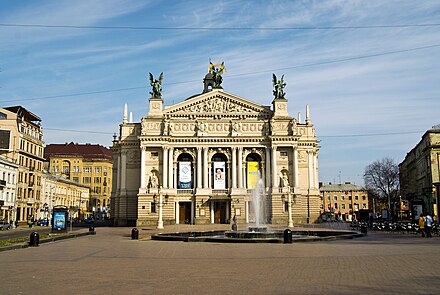
- Lviv (Lemberg), 49.8500°, 24.0167°. The capital of the Kingdom of Galicia and Lodomeria, and the Empire's largest city in present-day Ukraine. Today, it remains a bastion of Catholicism in majority Eastern Orthodox Ukraine.
- Chernivtsi (Czernowitz), 48.2922°, 25.9353°. The capital and university city of the formerly Austro-Hungarian region Bukovina, classic example of a strongly multi-ethnic region.
- Uzhhorod (Ungvár), 48.6239°, 22.295°. Capital of Carpatho-Ukraine that once belonged to the Hungarian half of the empire. Uzhhorod was a stronghold of the anti-Habsburg rebels during Rákóczi's War of Independence (1703–1711). Old town with Baroque Greek Catholic cathedral and former synagogue.
China
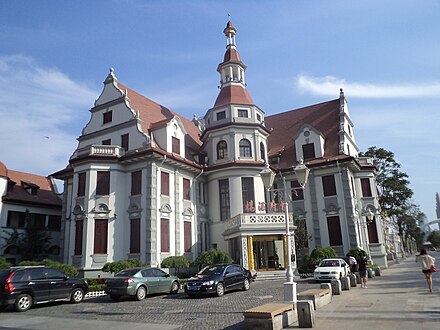
- Tianjin (Tientsin), 39.1336°, 117.2054°. The main port city serving the Chinese capital Beijing today, it was home to numerous foreign concessions in the 19th and early 20th centuries. Austria-Hungary was part of the Eight-Nation Alliance that suppressed the Qing Dynasty-backed Boxer Rebellion in 1901, resulting in it obtaining a concession in Tianjin from 1901-1917. Today, the former Austro-Hungarian concession is still home to numerous colonial buildings that were built in an Austrian architectural style.
Itineraries
- Orient Express, a legendary rail line between Paris and Istanbul, with much of its distance within Austria-Hungary
- The Danube flows through many of the most important cities of the former Empire
- EuroVelo cycling routes EV4 (Prague–Brno–Kraków–Lviv), EV6 (Danube Cycleway: Vienna–Bratislava–Budapest–Belgrade), EV7 (Prague–Linz–Salzburg–Bolzano), EV9 (Wrocław–Brno–Vienna–Ljubljana–Trieste), EV11 (Kraków–Košice–Szeged), EV13 (Iron Curtain Trail)
